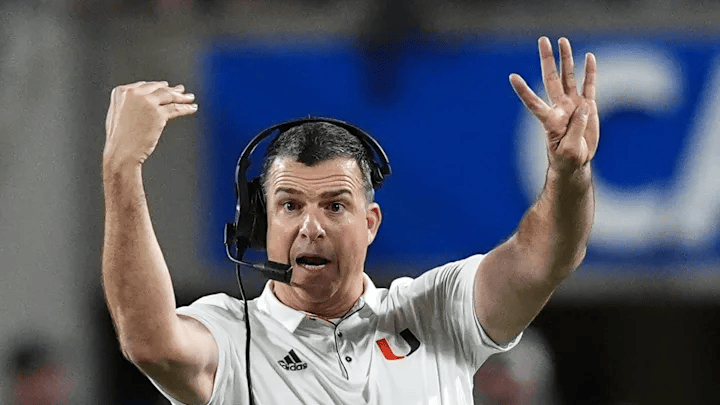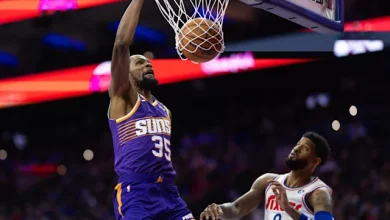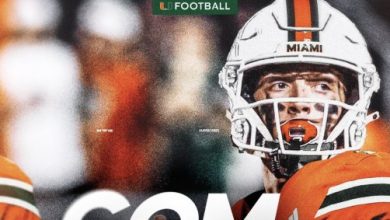In 2025, Mario Cristobal and the Miami Hurricanes may face difficulties.

In 2025, Mario Cristobal and the Miami Hurricanes face a pivotal year that could significantly shape the trajectory of their program. While Miami has always been a football powerhouse, the team has struggled in recent seasons to live up to the standards set by the glory years of the late 1980s and early 2000s. Cristobal, who took over as head coach in 2022, arrived with high expectations to return the Hurricanes to national prominence. However, the challenges he faces in 2025 are significant, and the path to success is far from guaranteed.
This piece will examine the potential difficulties that Mario Cristobal and the Miami Hurricanes may face in 2025, exploring the current state of the program, key areas of concern, the challenges in recruiting, and the pressure on Cristobal to deliver results. Additionally, we will discuss how the changing landscape of college football, including the expansion of the College Football Playoff (CFP) and the NIL (Name, Image, and Likeness) era, may influence the Hurricanes’ ability to compete with the best programs in the country.
The Pressure of Expectations
The University of Miami has long been associated with football success, boasting five national championships and producing countless NFL players. The Hurricanes’ dominant run in the 1980s and early 2000s established Miami as one of the most feared programs in college football. However, since their last national title in 2001, the program has faced a prolonged stretch of mediocrity, with only brief flashes of success.
Mario Cristobal, a Miami native and former Hurricane player, was hired with the hope that he would restore the program to its former glory. Cristobal had a successful stint at Oregon, where he led the Ducks to multiple Pac-12 championships and appeared in several major bowl games. His ability to recruit, especially along the offensive and defensive lines, was considered one of his strongest attributes. As a result, his hiring was seen as a home-run move for the Hurricanes, bringing a sense of optimism and excitement to a fanbase hungry for a return to national relevance.
However, as of 2025, Cristobal’s tenure has been far from smooth sailing. While he inherited a team that was far from elite, expectations for immediate success have created significant pressure. Miami’s struggles to contend in the highly competitive ACC and its inability to crack the top 25 rankings consistently have led to growing frustration among fans and alumni. Cristobal’s task in 2025 is not only to improve the team’s performance but also to deliver on the promise of restoring Miami as a national contender.
Recruiting Challenges: Competing in a Tough Landscape
One of the biggest difficulties Cristobal faces in 2025 is recruiting. Recruiting has always been a key to success in college football, and Cristobal’s reputation as a strong recruiter was one of the reasons Miami hired him in the first place. However, in the modern college football landscape, recruiting has become more competitive than ever, and Cristobal faces an uphill battle to bring top talent to Miami.
The state of Florida is a fertile recruiting ground, and Cristobal’s ability to tap into the talent-rich Miami area is critical to the success of the program. However, the Hurricanes are not the only team vying for recruits in this area. Florida State, the University of Florida, and even SEC powerhouses like Alabama and Georgia have increasingly recruited the state of Florida, making it more difficult for Miami to land its share of the best high school prospects.
The NIL era has also complicated recruiting. With players now able to profit from their name, image, and likeness, programs with deep-pocketed boosters and lucrative deals have a distinct advantage in attracting top talent. While Miami does have a strong booster base, the Hurricanes are not yet in the same position as schools like Texas, USC, or some SEC programs that have the financial resources to offer lucrative NIL deals to recruits. The ability to use NIL as a recruiting tool is essential for any major program, and Miami must find ways to stay competitive in this new era of college football.
Additionally, Cristobal’s offensive and defensive philosophies, which emphasize toughness, discipline, and control in the trenches, require elite talent. While Cristobal has been able to land some top-tier recruits, the overall talent gap between Miami and the perennial national contenders remains noticeable. In 2025, the Hurricanes still lack the depth and consistency across the roster to compete at the highest level. While Cristobal has brought in strong recruiting classes, it will take time for them to develop and for the program to build sustained success.
The Offensive Struggles
A major difficulty for Cristobal and the Hurricanes in 2025 is the inconsistency on offense. Despite his background as an offensive line coach, Cristobal has struggled to field a potent offense at Miami. In his first few seasons, the offense has lacked identity, with issues at quarterback, offensive line play, and the lack of a consistent playmaker at running back or wide receiver.
At quarterback, Miami has been searching for stability since the departure of D’Eriq King. Despite bringing in talent, including transfers and highly-rated recruits, the Hurricanes have yet to settle on a long-term solution under center. Quarterback play is arguably the most important position in college football, and without consistent play at that position, it’s difficult to build an offense capable of competing for championships.
Moreover, Miami’s offensive line, while improved under Cristobal’s tutelage, has still shown weaknesses. In the modern game, an elite offensive line is essential not only for protecting the quarterback but also for establishing a balanced running game. The lack of an elite offensive line has hampered the team’s ability to control the tempo of the game and impose their will offensively. In 2025, the Hurricanes’ offensive line still appears to be a work in progress, and their inability to consistently dominate in the trenches remains a major point of concern.
The lack of consistent playmakers at wide receiver and running back is another obstacle. While Miami has recruited some solid skill position players, they have yet to find a true star that can take over games and make an impact at the highest level. In an era where dynamic playmakers can change the course of a game, Miami’s offensive struggles have been a limiting factor in their ability to compete with elite teams.
Defensive Challenges: Adjusting to Modern Offenses
On the defensive side of the ball, Mario Cristobal faces additional challenges in 2025. While the Hurricanes have had some success on defense under Cristobal, they have not yet been able to consistently shut down the high-powered offenses of the ACC and other major conferences. As the league continues to evolve, Cristobal’s defense must adapt to the changing nature of college football, where high-tempo offenses and dynamic quarterbacks are becoming the norm.
In recent years, Miami has had some talent on defense, especially in the secondary and at linebacker. However, they have been inconsistent in their ability to generate pressure on the quarterback, and their defensive line play has been a weak spot. As offenses become faster and more dynamic, the ability to stop the run and pressure the quarterback is more important than ever. Cristobal and defensive coordinator Kevin Steele will need to adjust their scheme to better handle the modern spread offenses that have taken over college football.
One key challenge for Cristobal is recruiting elite defensive linemen and edge rushers. While the Hurricanes have had some talent at the position, they have not consistently landed the type of difference-makers that can disrupt the flow of a game. In 2025, if Miami is to contend for championships, they must develop a more consistent pass rush and improve their ability to get after opposing quarterbacks.
The Changing Landscape of College Football
The college football landscape in 2025 is significantly different from the one Mario Cristobal faced when he took over at Miami. The expansion of the College Football Playoff (CFP) to 12 teams creates more opportunities for teams to make the postseason, but it also means that the competition for those spots is fiercer than ever. Cristobal and the Hurricanes must not only compete within the ACC but also contend with other Power Five schools from across the country.
In addition, the changing dynamics of NIL deals, the transfer portal, and shifting conference alignments will all have a profound impact on Miami’s ability to recruit and build a competitive roster. Programs with more financial resources or a larger national footprint may have an edge when it comes to attracting top talent, and Miami must find creative ways to compete in this new era.









